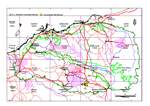Click on images
to enlarge



Photographer: B.R. Maslin

Photographer: B.R. Maslin

Juvenile growth habit. Photographer: B.R. Maslin

Photographer: B.R. Maslin

Photographer: B.R. Maslin

Photographer: B.R. Maslin

Photographer: B.R. Maslin
Botanical name
Acacia aneura var. microcarpa Pedley, Fl. Australia 11B: 489 (2001)
Common name
Mulga
Note
Acacia aneura and related species form a very complex and polymorphic assemblage of taxa with A. aneura itself the most variable (see Miller et al. 2002 for discussion). These species are currently under review therefore the classification here of Pilbara entities referable to A. aneura is provisional. Currently 10 varieties are recognized within A. aneura (Pedley 2001) of which six appear to occur in the Pilbara. These varieties encompass most of the variation in Mulga in the Pilbara and are the entities upon which this Wattles of the Pilbara treatment of Mulga is based. It is often difficult to distinguish between the varieties, and between A. aneura and related species (especially A. ayersiana and A. paraneura) on account of seemingly intermediate forms. In past literature it is often not possible to know to which of the varieties the information applies. Therefore, we have assembled these data under the heading of A. aneura. The data presented below for A. aneura var. microcarpa is derived from our field and herbarium studies of only the Pilbara plants of this entity.
Description
Rounded shrubs maturing to ±obconic small trees 3-5 (-7+) m tall with dense to sub-dense, rounded crowns, dividing at or just above ground level into few to many ±straight, ascending to erect main stems. Branchlets resin-ribbed (the resin opaque and often forming a thick crenulated layer which ages white) and obscurely sericeous between ribs at extremities. New shoots dark red-brown and resinous when first initiated, (sometimes completely enveloped with a layer of opaque resin). Phyllodes narrowly linear, 40-80 mm long, 1 mm wide, flat to terete, mostly shallowly or moderately incurved, sometimes interspersed with some that are straight or shallowly sigmoid, light grey-green to sub-glaucous or sometimes glaucous; parallel longitudinal nerves numerous, close together and indistinct, resinous (resin often obscuring the nerves and the appressed hairs that occur between them); apices mostly sub-uncinate or uncinate. Gland 0-4 mm above pulvinus. Inflorescences simple; peduncles 3-6 mm long; spikes 15-20 mm long. Sepals free, linear-spathulate. Pods 10-40 mm long, 5-8 mm wide, flat, papery, obscurely and sparingly reticulately longitudinally nerved, glabrous or appressed-hairy when young but glabrous with age, greyish brown; marginal wing narrow (about 1 mm wide) by an indistinct intra-marginal nerve. Seeds longitudinal in pods, 3.5-4 mm long, 2-2.5 mm wide.
Distribution and ecology
In the Pilbara most populations of this variety occur in the vicinity of West Angelas in the central part of the Hamersley Range but it is also recorded from near Paraburdoo. Grows on alluvial plains and slopes and summit of low rocky hills, in stony red-brown loam or loamy clay, sometimes along diffuse, shallow water courses. The overall range of var. microcarpa is given by Pedley (2001) scattered in the arid zone from the Pilbara and Murchison-Ashburton region of Western Australia to Northern Territory and South Australia.
Flowering and fruiting period
Flowering and fruiting is most likely determined by the timing and intensity of rainfall events. Because of the paucity of collections it is difficult to precisely determine the phenology of this variety but from specimens to hand it is seen that flowering finishes in early June and pods with mature seed occur in late September. It is probable that this variety flowers in April and/or May and sets mature seed from late September to about mid-October.
Variation
Phyllodes vary from flat to terete; both types may occur within a single population.
Affinities
This variety may superficially resemble A. aneura var. intermedia which also grows in the West Angelas area but which has wider phyllodes and obscurely translucent resin-ribbed branchlets.
Conservation status
Not considered rare or endangered.
Origin of name
The varietal name is derived from the Greek micro- (small) and karpos (fruit) in allusion to the relatively small pods found on this taxon.
References
Miller, J.T., Andrew, R.A. and Maslin, B.R. (2002). Towards an understanding of variation in the Mulga complex (Acacia aneura and relatives). Conservation Science Western Australia 4(3): 19-35.
Pedley, L. (2001). Acacia aneura. pp. 314-322. In: A.E. Orchard and A.J.G. Wilson (eds) Flora of Australia. Volume 11B. pp. 536. (ABRS/CSIRO Publishing: Australia.)
